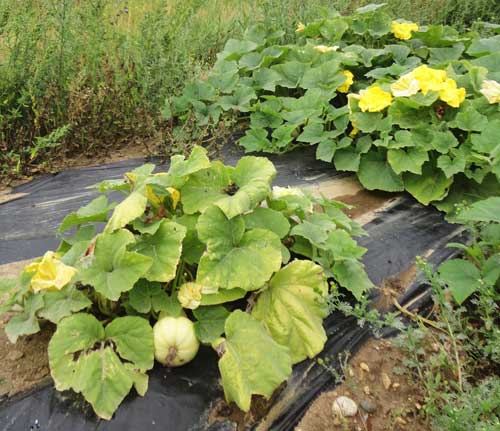How to Conserve Water in Your Garden

How to conserve water in the garden?
There are a good many ways that the organic gardener can save on watering and time and energy, too. Save money on your water bill and help lower your energy footprint by using some of these easy eco-friendly ideas for water conservation.
Picture: Woods in May; plant communities in nature help each other by conserving water.
How to save water at planting time
If you are wanting to plant new areas of the garden, choose less thirsty species and plant mainly in autumn and spring, taking advantage of damp conditions. That way you reduce the need for much watering after planting.
If the soil is already damp you will most likely only need to water at the time of planting and perhaps one additional time thereafter as an insurance.
Use water from the rain butt before you resort to tap water. Water copiously but infrequently. This is more effective than watering little and often.
Prevent run-off and evaporation by the careful use of mulches and plant covers.
How to conserve water:
Summer watering

If you need to water plants in summer during dry spells, always water as early as possible in the morning or water in the evening after the heat of the day. This is more efficient as less of the water will evaporate from hot soil. Plants benefit more, too, because water droplets on leaves in strong sunlight may cause local damage as the droplets magnify the heat of the sun.
Picture: Squash mulched with plastic sheeting
For most plants avoid watering routinely; many plants will respond to this by developing shallow roots. It is far better to water only when necessary. Put a trowel or a dibber into the soil and ease it back to reveal the soil under the surface. If there is evidence of moisture a couple of inches or so under the surface you should not need to water at all, except maybe for newly transplanted seedlings with shallow roots.
Use mulches and ground cover to reduce water needs and plant your flowers and vegetables in self-supporting communities. Although large plants can “rob” moisture from smaller ones, it is also noticeable that many plants help each other conserve moisture by providing shade and a dense growth that prevents evaporation.
Bare soil is best avoided, as it will lose moisture in warm dry weather. It also loses fertility. So, to prevent this use either temporary cover such as black plastic sheeting or sow a good layer of green manure species such as clover or Phacelia. Phacelia tanacetifolia is both attractive and good for encouraging bees and hoverflies.
You can also use careful inter-planting to try to replicate the natural plant communities which abound in nature. Choose a mixture of smaller and larger plants. Smaller ones should be more shade-tolerant. For example, lettuce and basil often do well interplanted between tomato plants.
Crop covers such as horticultural fleece also help prevent undue evaporation from beds and plants and provide a degree of shade. Use them for vulnerable crops such as lettuce and other salad plants. You can water straight on top of the permeable sheets without removing them, though I think it is helpful to remove them often to inspect the crop, check soil moisture and check for pests.
How to conserve water:
Watering aids
One way of aiding watering and conserving water use at the same time is to use a bottle for direct watering. You remove the base of a plastic drinks bottle, dig a hole beside the plant you want to take care of and insert the upside down bottle into the hole. When you want to water the plant simply tip water into the base of the bottle and it will go straight to the base of the plant and water the roots and soil in just the right place.
The main downside of this is that you need a plastic bottle! If you have already excluded most of these from your lifestyle it isn’t hard to pick up other people’s throwaways – which, of course, are all too common in our local environments. Also, the beauty of the garden is not much enhanced by pieces of plastic tucked between plants. Earthenware pots can also be used as they lose water slowly from the surfaces. They do need to be unglazed, of course.
Sponsored links
How to conserve water:
Grey water usage
Use grey water to irrigate plants or lawns. Grey water is left-over water from doing washing up or hand washing. You can also use bath water. You can install a special device for siphoning off the water.
It is advisable to use eco-friendly washing products – detergents and soaps. Many products contain artificial fragrances and other chemicals that are damaging for the environment. Most plants can cope with a small amount of soap or dishwashing detergent without contamination or affecting growth.
Reduce your lawn size and use green growing techniques to reduce the amount of water needed to keep it green. It is a good idea to only keep a lawn on relatively flat areas. A gradient makes it harder to keep the soil well irrigated and lawns in such places may well be thirsty. A better option may be to plant low growing shrubs and ground cover. Trees and small shrubs create shady areas which will remain green in all but the most punishingly hot weather.
*****
How to Conserve Water in the Garden - top of page
l
l
Greenfootsteps Home - for more easy green living ideas
How to Conserve Water in the Garden
Copyright Greenfootsteps.com 2013
| Tweet |

| Tweet |

On other pages
Sponsored links
Footprints
- an occasional e-zine from Greenfootsteps
If you would like to receive the e-zine, please just sign up below.






New! Comments
Have your say about what you just read! Leave me a comment in the box below.